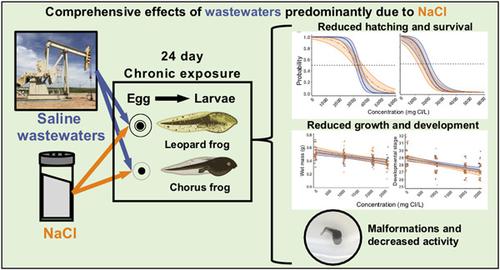当前位置:
X-MOL 学术
›
Environ. Toxicol. Chem.
›
论文详情
Our official English website, www.x-mol.net, welcomes your
feedback! (Note: you will need to create a separate account there.)
Comparative Effects of Energy-Related Saline Wastewaters and Sodium Chloride on Hatching, Survival, and Fitness-Associated Traits of Two Amphibian Species
Environmental Toxicology and Chemistry ( IF 3.6 ) Pub Date : 2021-08-18 , DOI: 10.1002/etc.5193 Brian J Tornabene 1 , Creagh W Breuner 1 , Blake R Hossack 1, 2
Environmental Toxicology and Chemistry ( IF 3.6 ) Pub Date : 2021-08-18 , DOI: 10.1002/etc.5193 Brian J Tornabene 1 , Creagh W Breuner 1 , Blake R Hossack 1, 2
Affiliation

|
Salinity (sodium chloride [NaCl]) is a prevalent and persistent contaminant that negatively affects freshwater ecosystems. Although most studies focus on effects of salinity from road salts (primarily NaCl), high-salinity wastewaters from energy extraction (wastewaters) could be more harmful because they contain NaCl and other toxic components. Many amphibians are sensitive to salinity, and their eggs are thought to be the most sensitive life-history stage. However, there are few investigations with salinity that include eggs and larvae sequentially in long-term exposures. We investigated the relative effects of wastewaters from a large energy reserve, the Williston Basin (USA), and NaCl on northern leopard (Rana pipiens) and boreal chorus (Pseudacris maculata) frogs. We exposed eggs and tracked responses through larval stages (for 24 days). Wastewaters and NaCl caused similar reductions in hatching and larval survival, growth, development, and activity, while also increasing deformities. Chorus frog eggs and larvae were more sensitive to salinity than leopard frogs, suggesting species-specific responses. Contrary to previous studies, eggs of both species were less sensitive to salinity than larvae. Our ecologically relevant exposures suggest that accumulating effects can reduce survival relative to starting experiments with unexposed larvae. Alternatively, egg casings of some species may provide some protection against salinity. Notably, effects of wastewaters on amphibians were predominantly due to NaCl rather than other components. Therefore, findings from studies with other sources of increased salinity (e.g., road salts) could guide management of wastewater-contaminated ecosystems, and vice versa, to mitigate effects of salinization. Environ Toxicol Chem 2021;40:3137–3147. © 2021 SETAC
中文翻译:

与能量相关的含盐废水和氯化钠对两种两栖动物孵化、生存和健康相关性状的比较影响
盐度(氯化钠 [NaCl])是一种普遍存在且持久的污染物,会对淡水生态系统产生负面影响。尽管大多数研究都集中在道路盐分(主要是 NaCl)的盐分影响上,但来自能源提取的高盐分废水(废水)可能更有害,因为它们含有 NaCl 和其他有毒成分。许多两栖动物对盐分敏感,它们的卵被认为是最敏感的生活史阶段。然而,很少有关于盐度的调查,包括在长期暴露中依次出现的卵和幼虫。我们调查了来自大型能源储备、威利斯顿盆地(美国)和 NaCl 的废水对北豹 ( Rana pipiens ) 和北方合唱 ( Pseudacris maculata ) 的相对影响) 青蛙。我们暴露卵子并跟踪幼虫阶段的反应(24 天)。废水和 NaCl 导致孵化和幼虫存活、生长、发育和活动的类似减少,同时也增加了畸形。合唱蛙卵和幼虫比豹蛙对盐度更敏感,表明物种特异性反应。与之前的研究相反,这两个物种的卵对盐度的敏感性低于幼虫。我们的生态相关暴露表明,相对于未暴露的幼虫开始实验,累积效应会降低存活率。或者,某些物种的蛋壳可以提供一些防止盐分的保护。值得注意的是,废水对两栖动物的影响主要是由于 NaCl 而不是其他成分。所以,环境毒物化学2021;40:3137–3147。© 2021 SETAC
更新日期:2021-10-27
中文翻译:

与能量相关的含盐废水和氯化钠对两种两栖动物孵化、生存和健康相关性状的比较影响
盐度(氯化钠 [NaCl])是一种普遍存在且持久的污染物,会对淡水生态系统产生负面影响。尽管大多数研究都集中在道路盐分(主要是 NaCl)的盐分影响上,但来自能源提取的高盐分废水(废水)可能更有害,因为它们含有 NaCl 和其他有毒成分。许多两栖动物对盐分敏感,它们的卵被认为是最敏感的生活史阶段。然而,很少有关于盐度的调查,包括在长期暴露中依次出现的卵和幼虫。我们调查了来自大型能源储备、威利斯顿盆地(美国)和 NaCl 的废水对北豹 ( Rana pipiens ) 和北方合唱 ( Pseudacris maculata ) 的相对影响) 青蛙。我们暴露卵子并跟踪幼虫阶段的反应(24 天)。废水和 NaCl 导致孵化和幼虫存活、生长、发育和活动的类似减少,同时也增加了畸形。合唱蛙卵和幼虫比豹蛙对盐度更敏感,表明物种特异性反应。与之前的研究相反,这两个物种的卵对盐度的敏感性低于幼虫。我们的生态相关暴露表明,相对于未暴露的幼虫开始实验,累积效应会降低存活率。或者,某些物种的蛋壳可以提供一些防止盐分的保护。值得注意的是,废水对两栖动物的影响主要是由于 NaCl 而不是其他成分。所以,环境毒物化学2021;40:3137–3147。© 2021 SETAC











































 京公网安备 11010802027423号
京公网安备 11010802027423号